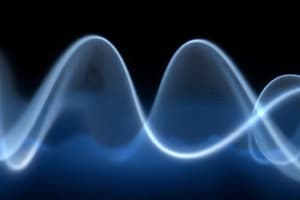Podcast
Questions and Answers
What occurs to the wave fronts when a sound source moves towards an observer?
What occurs to the wave fronts when a sound source moves towards an observer?
- The wave fronts expand further apart.
- The wave frequency remains unchanged.
- The wave intensity decreases.
- The wave fronts compress together. (correct)
What effect is observed when an object moves away from an observer in terms of light frequency?
What effect is observed when an object moves away from an observer in terms of light frequency?
- It causes green shifting.
- It has no effect on light frequency.
- It causes red shifting. (correct)
- It causes blue shifting.
How does the speed of the source relative to the wave speed affect the Doppler shift?
How does the speed of the source relative to the wave speed affect the Doppler shift?
- It only affects the Doppler effect in electromagnetic waves.
- Higher speeds make shifts easier to detect in sound waves than in light waves. (correct)
- It has no impact on the Doppler shift.
- Higher speeds only affect the shift in light waves significantly.
What should you use in the Doppler Shift formula if the source is moving away from the observer?
What should you use in the Doppler Shift formula if the source is moving away from the observer?
What changes occur to the apparent frequency of a wave when its source is moving towards an observer?
What changes occur to the apparent frequency of a wave when its source is moving towards an observer?
Which of the following statements is true regarding the Doppler shift?
Which of the following statements is true regarding the Doppler shift?
What happens to the frequency of a wave when the source moves at a speed equal to the speed of the wave?
What happens to the frequency of a wave when the source moves at a speed equal to the speed of the wave?
If a source is stationary, what effect does it have on the frequency of the waves observed?
If a source is stationary, what effect does it have on the frequency of the waves observed?
If a source is moving towards an observer at a high speed, what is the expected outcome in terms of frequency?
If a source is moving towards an observer at a high speed, what is the expected outcome in terms of frequency?
What structural feature differentiates human mandibles from those of apes?
What structural feature differentiates human mandibles from those of apes?
Which of the following statements about chimpanzees is correct?
Which of the following statements about chimpanzees is correct?
How do the zygomatic arches of apes compare to those of humans?
How do the zygomatic arches of apes compare to those of humans?
What dietary difference contributed to the evolutionary changes in the human lower facial skeleton?
What dietary difference contributed to the evolutionary changes in the human lower facial skeleton?
Which feature of apes aids in force dispersion during jaw movement?
Which feature of apes aids in force dispersion during jaw movement?
What is the primary function of forward-facing eyes in primates?
What is the primary function of forward-facing eyes in primates?
Which primate is most genetically similar to humans?
Which primate is most genetically similar to humans?
What is the primary purpose of molars and premolars in primates?
What is the primary purpose of molars and premolars in primates?
What distinguishes the human dental arcade from that of chimpanzees?
What distinguishes the human dental arcade from that of chimpanzees?
Which feature of the skull helps withstand the forces developed during chewing and biting?
Which feature of the skull helps withstand the forces developed during chewing and biting?
What is the role of the sagittal crest in some primates?
What is the role of the sagittal crest in some primates?
How does prognathism affect the facial structure of primates?
How does prognathism affect the facial structure of primates?
What structural feature of the cranium protects the brain?
What structural feature of the cranium protects the brain?
Flashcards are hidden until you start studying
Study Notes
Doppler Shift Overview
- Doppler shift refers to the change in a wave's apparent frequency due to relative motion between the source and the observer.
- Source moving towards the observer compresses wave fronts, resulting in a higher frequency.
- Source moving away from the observer elongates wave fronts, leading to a lower frequency.
Applicability to Waves
- This phenomenon is observed across all types of waves, including sound and light.
- The extent of frequency shift is more pronounced in sound waves compared to light waves.
Light and Color Shifting
- In visible light, frequency changes correspond to color changes.
- Objects receding from the observer undergo red shifting, moving to the lower frequency (red) end of the spectrum.
- Objects approaching the observer experience blue shifting, moving to the higher frequency (blue) end of the spectrum.
Doppler Shift Formula
- The formula for calculating the Doppler shifted frequency:
- ( f' = f \pm \frac{vw}{vs} )
- Where:
- ( f' ) = Doppler shifted frequency
- ( f ) = Normal frequency
- ( vw ) = Speed of the wave
- ( vs ) = Speed of the source
Direction Indicators
- The "+" or "-" in the formula depends on the direction of motion:
- Use "-" when the source moves towards the observer (bracketed value larger).
- Use "+" when the source moves away from the observer (bracketed value smaller).
Typical Features of Primates
- Forward-facing eyes enhance depth perception and 3D vision, advantageous for predators.
- Prehensile digits allow manipulation of objects and gripping capabilities.
- Nails facilitate better grip and increase contact with objects compared to claws.
- Fingerprints improve tactile sensation and provide additional grip.
Humans are Primates
- Human DNA is 95% similar to that of other primates, indicating close genetic relationships.
- Chimpanzees, especially bonobos, share the closest genetic link to humans, highlighting a recent common ancestor.
- Humans did not evolve from chimpanzees; rather, both species diverged from a shared ancestor.
Features of the Primate Skull (Gorilla beringei beringei)
- Cranium protects the brain from injury and supports the structure of the head.
- Brow ridge provides protection to the eyes during chewing and biting.
- Canine teeth are sharp and specialized for grasping, killing prey, and demonstrating aggression.
- Zygomatic arch supports chewing muscles that connect to the mandible and skull.
- Nuchal crest serves as an attachment point for neck muscles that stabilize the head.
- Sagittal crest accommodates powerful jaw muscles, aiding in biting and chewing.
- Molars and premolars are flat teeth optimized for crushing food.
- Foramen magnum is the opening at the skull's base where the spinal cord enters.
- Diastema creates space for canine teeth while allowing other teeth to mesh.
- Prognathism describes the forward projection of the lower face.
Human vs. Chimpanzee Skull
- Chimpanzees possess a robust, rectangular jaw compared to the rounded mandible of humans.
- Human dental arcade is wider with smaller teeth, while chimpanzees display a pronounced dental arcade.
- Apes feature a prominent "shelf" behind the chin, in contrast to humans, who have a protruding chin without a simian shelf.
- Chimpanzee faces exhibit prognathism, leading to a forward-projecting lower portion, while humans exhibit less or no prognathism.
- The foramen magnum's position differs; in humans, it is located more inferiorly than in apes.
- Chimpanzees have larger molars and canines due to their fibrous diet, necessitating a strong bite force.
- Chimpanzee skulls have extensive muscle attachments for powerful bites, with a wide zygomatic arch and prominent sagittal crest for muscle support.
- In contrast, modern humans consume cooked foods, resulting in reduced jaw musculature, less robust skull features, and the absence of a sagittal crest.
Studying That Suits You
Use AI to generate personalized quizzes and flashcards to suit your learning preferences.




